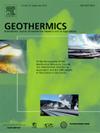地热勘探的地球化学和同位素方法:解读墨西哥下加利福尼亚州San Miguel-Vallecitos断裂系统热流体中的流体-岩石相互作用
IF 3.9
2区 工程技术
Q3 ENERGY & FUELS
引用次数: 0
摘要
尽管缺乏最近的岩浆活动,热流体在下加利福尼亚州普遍存在,特别是沿着活跃的断层系统。本文以墨西哥下加利福尼亚州的圣米格尔-瓦列西托斯断层系统(SMVFS)为研究对象,该地区受北美板块下方法拉隆板块的不活跃俯冲和加利福尼亚湾的活跃裂陷的影响。这些事件塑造了断层系统,并可能促成了今天观测到的热流体。本研究探讨了温泉的地球化学和同位素组成,包括溶解气体和冒泡气体,以1)使用经典溶质和多组分地温计估算储层温度;2)表征氦的来源,并确定SMVFS的地幔氦比例是否与上升的地幔流体、最近的岩浆活动或地壳来源的残余氦(岩浆老化)有关。根据温泉的地理分布和化学同位素组成,将温泉分为两类。组1水域位于SMVFS的南部,温度范围为28°C至35°C,总溶解固体(TDS)范围为0.22至0.36 g L−1,而组2水域位于北部,温度为52°C和52.8°C, TDS值为0.63和0.69 g L−1。利用溶质地温计估算的温度可以确定一个低温地热系统,估计最高温度主要是在2组水(高达112°C)。两组气体组成均以n2为主,He和CH4的浓度均高于CO2。氦同位素比值(0.04-0.52Ra)和4He/20Ne比值(8.4-206.2)表明大部分氦为放射性成因。然而,幔源氦的比例沿SMVFS由南向北增加,在第二组达到6.3%,在那里测量到最高的出口温度。岩浆老化模型无法解释SMVFS中流体的3He/4He比率,特别是第2组流体的较高比率,这使我们能够解释研究区域发生的较晚的岩浆岩后岩浆事件或地幔流体沿着可渗透的SMVFS迁移,第二种假设考虑到区域地质背景更有可能。本文章由计算机程序翻译,如有差异,请以英文原文为准。
A geochemical and isotopic approach for geothermal exploration: Deciphering fluid-rock interaction in thermal fluids of San Miguel-Vallecitos fault system, Baja California, Mexico
Thermal fluids are commonly found in Baja California, particularly along active fault systems, despite the lack of recent magmatic activity. This study focuses on the San Miguel-Vallecitos Fault System (SMVFS) in Baja California, Mexico, a region influenced by the now inactive subduction of the Farallon plate beneath the North American plate and the active rifting of Gulf of California. These events have shaped the fault systems and could contribute to the thermal fluids observed today. This study explores the geochemical and isotopic composition of thermal springs, including dissolved and bubbling gases to 1) estimate reservoir temperatures using classic solute and multicomponent geothermometers and 2) characterize the origin of helium and determine if the mantle helium proportion along SMVFS is related to rising mantle fluids, recent magmatic activity or residual 3He from crustal sources (magma aging).
The thermal springs are subdivided into 2 groups based on their geographical distribution and chemical and isotopic compositions. Group 1 waters, localized in the southern sector of the SMVFS with temperatures ranging from 28 °C to 35 °C and total dissolved solids (TDS) from 0.22 to 0.36 g L−1, in contrast Group 2 waters in the northern sector have temperatures of 52 °C and 52.8 °C and TDS values of 0.63 and 0.69 g L−1. The temperature estimated using solute geothermometers allows to identify a low-temperature geothermal system, with the highest temperature mostly estimated for Group 2 waters (up to 112 °C). Both groups show N2-dominated gas composition, with higher concentrations of He and CH4 compared to CO2. Helium isotopes ratio (0.04–0.52Ra) and 4He/20Ne ratios (8.4–206.2) allowed to identify that most of the helium is of radiogenic origin. However, the proportion of mantle-derived He increases from south to north along the SMVFS, reaching 6.3 % in Group 2, where the highest outlet temperatures were measured. The 3He/4He ratios of fluids along the SMVFS cannot be explained by a magma aging model, especially the higher ratios of Group 2, allowing us to decipher that either a more recent post batholitic magmatic event occurred in the studied area or fluids from the mantle are migrating along the permeable SMVFS, the second hypothesis being more likely considering the regional geological context.
求助全文
通过发布文献求助,成功后即可免费获取论文全文。
去求助
来源期刊

Geothermics
工程技术-地球科学综合
CiteScore
7.70
自引率
15.40%
发文量
237
审稿时长
4.5 months
期刊介绍:
Geothermics is an international journal devoted to the research and development of geothermal energy. The International Board of Editors of Geothermics, which comprises specialists in the various aspects of geothermal resources, exploration and development, guarantees the balanced, comprehensive view of scientific and technological developments in this promising energy field.
It promulgates the state of the art and science of geothermal energy, its exploration and exploitation through a regular exchange of information from all parts of the world. The journal publishes articles dealing with the theory, exploration techniques and all aspects of the utilization of geothermal resources. Geothermics serves as the scientific house, or exchange medium, through which the growing community of geothermal specialists can provide and receive information.
 求助内容:
求助内容: 应助结果提醒方式:
应助结果提醒方式:


